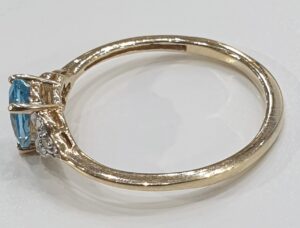A Seamless Restoration for Delicate Rings
An overlapping join is a specialised jewellery technique specifically designed to reinforce and resize rings with very fine shanks, those most susceptible to breakage from a simple solder repair. It’s a meticulous process that leverages the existing metal of the ring to create a significantly stronger structure, all while achieving a virtually undetectable finish. Here’s a detailed breakdown of the steps involved, along with its benefits and some crucial considerations:
The Process:
Strategic Cut: The first step involves identifying a discreet location on the ring’s shank for a clean cut. Ideally, this location would be hidden by a design element later, or positioned on the underside of the ring for maximum invisibility. A jeweller uses specialised tools like a jeweller’s saw or laser cutter to make a precise cut, ensuring a clean and even surface for the join.
Substantial Overlap: Unlike a standard resize where minimal overlap might suffice, this technique requires a more substantial overlap due to the ring’s delicate nature. The jeweller carefully overlaps one end of the shank onto the other, ensuring a perfect alignment to minimize any visible seam. The amount of overlap will depend on the desired level of reinforcement and the additional ring size needed.
Soldering for Strength: Soldering is the process of fusing the two overlapped sections using a heated metal alloy with a lower melting point than the ring itself. The jeweller applies a small amount of solder paste along the seam of the overlap. The ring is then heated using a torch until the solder melts and flows, creating a strong and permanent bond between the two overlapped portions.
Shaping Through Hammering: After soldering, the overlapped section will naturally be thicker and potentially uneven compared to the rest of the ring. To restore a smooth and consistent form, the jeweller employs a specialized hammering technique. They meticulously tap the overlapped area with specific tools, carefully shaping and thinning it back down to match the original profile of the ring shank. This step requires a practiced hand and a good eye to ensure the ring maintains its roundness and overall shape, even with the additional material.
Flawless Finish: The final step involves meticulous filing and polishing the overlapped area to remove any imperfections or marks left by the hammering process. This step refines the join and ensures a smooth, seamless finish that blends in perfectly with the rest of the ring, even on plain bands.
Benefits of an Overlapping Join:
Reinforced Durability: The primary benefit of an overlapping join is the dramatic increase in the ring’s strength and durability. The substantial overlap creates a significantly thicker and more robust structure, making the ring far less susceptible to bending or breaking, especially crucial for previously very fine shanks.
Effective Resizing: This technique effectively addresses resizing needs for delicate rings. By controlling the amount of overlap, the jeweller can add a specific amount of material to the ring’s circumference, achieving the desired new size while maintaining the ring’s integrity.
Cost-Effective Restoration: Compared to completely replacing a cherished ring, an overlapping join offers a more cost-effective solution for restoring its functionality and structural integrity.
Additional Considerations:
Material Suitability: The overlapping join technique is best suited for rings made of precious metals like gold and platinum that can be soldered effectively.
Jeweller’s Expertise: A skilled and experienced jeweller is crucial for achieving a seamless and aesthetically pleasing result. Their expertise ensures a precise cut, proper soldering technique, and meticulous shaping and finishing of the overlapped area.
An overlapping join, when done with precision and care, can transform a delicate ring at risk of breaking into a strong and beautiful piece. It offers a practical and cost-effective solution for strengthening and resizing precious pieces, allowing them to be cherished for years to come.
This picture is an example of the join overlap, which is then hammered down to lay flat and smooth. the join is then refined to a point where it ends up looking like the picture below.


